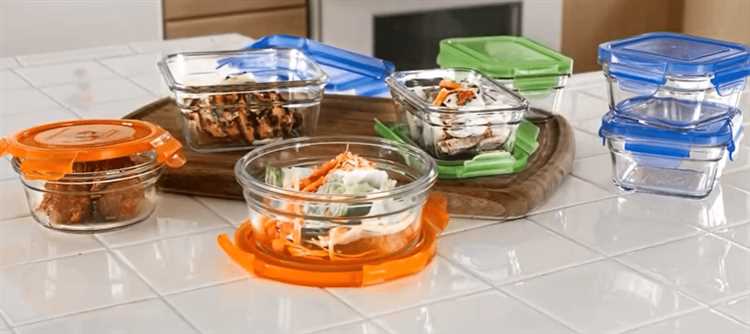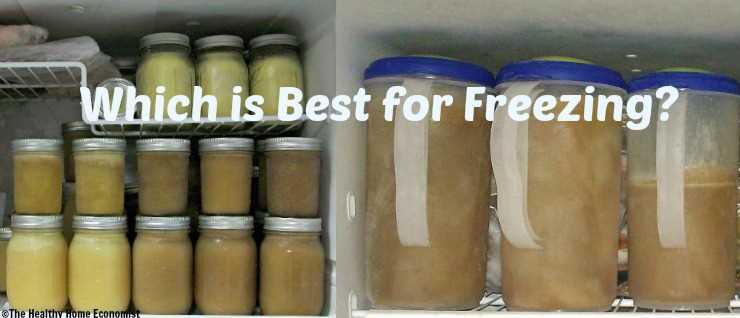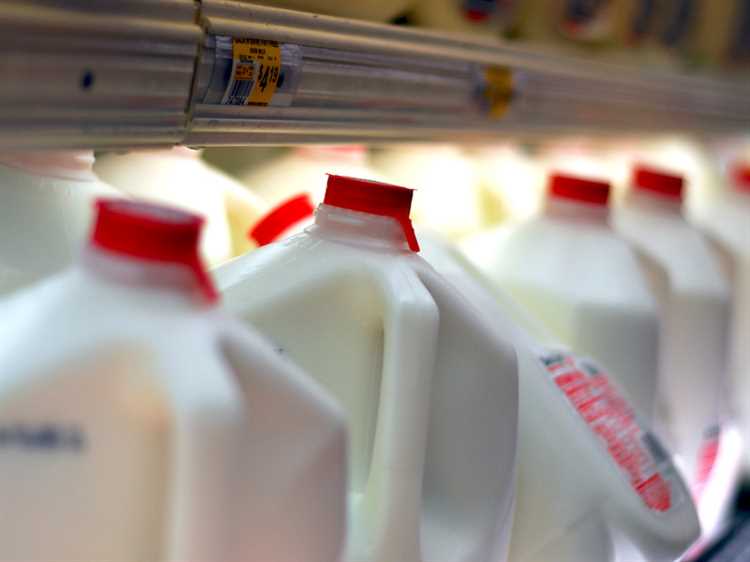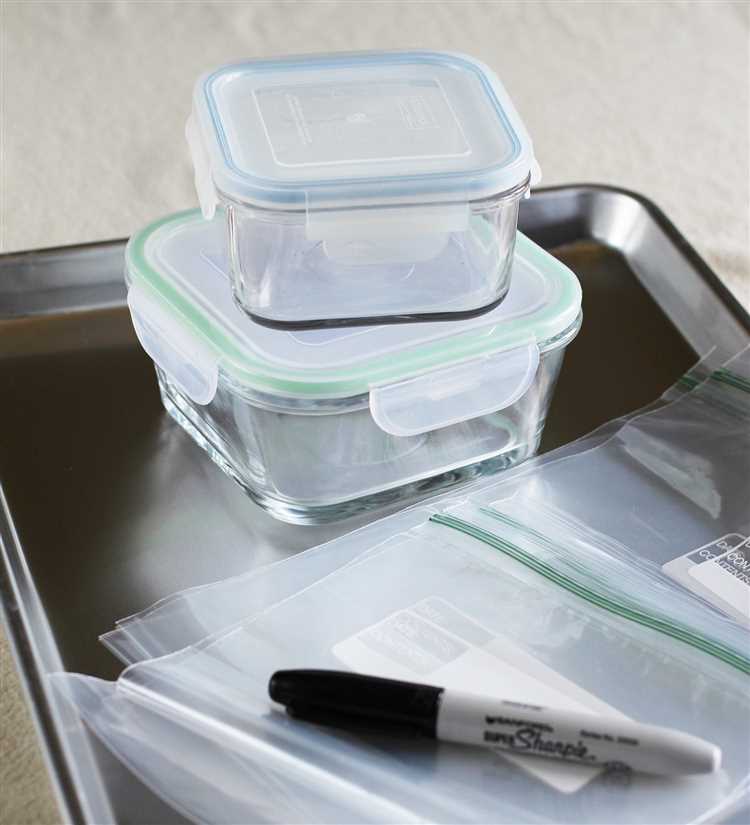
When it comes to freezing items in a container, not all materials are created equal. Some materials can withstand freezing temperatures without any issues, while others can crack, break, or even become hazardous when exposed to extreme cold. If you’re wondering which materials to avoid freezing in a container, read on to find out.
First and foremost, it’s important to avoid freezing liquids in glass containers. While glass may be a sturdy material, it is prone to cracking or shattering when subjected to rapid temperature changes. When liquids freeze, they expand, and this expansion can put immense pressure on the glass, causing it to break. To avoid any potential accidents or injuries, it’s best to transfer liquids to a freezer-safe container made of a more durable material, such as plastic or stainless steel.
In addition to glass, certain plastics are also not suitable for freezing. Polyethylene terephthalate (PET), which is commonly used for single-use water bottles, can become brittle and break when frozen. High-density polyethylene (HDPE), on the other hand, is more resistant to freezing and is commonly used for freezer bags and containers. To determine if a plastic container is suitable for freezing, look for the freezing symbol on the packaging or check the manufacturer’s instructions.
Another material to avoid freezing in a container is metal. While metal containers may not crack like glass or plastic, they can still be affected by extreme cold. When metal gets very cold, it can become brittle and lose its structural integrity. Additionally, freezing liquids in metal containers can cause them to expand and potentially deform the container. It’s best to opt for non-metallic containers when freezing items to avoid any unwanted consequences.
- Why Freezing Certain Materials Can Be Problematic in Containers
- 1. Glass
- 2. Metal
- The Effects of Freezing on Plastic
- The Risks of Freezing Glass and Ceramic
- 1. Damage and Breakage
- 2. Contamination
- Problems with Freezing Metal Containers
- 1. Metal Fatigue
- 2. Corrosion
- The Dangers of Freezing Liquids in Containers
- Potential Health Risks
- Avoiding Freezing Paper and Cardboard
- Other Materials to Keep Away from Freezing
- 1. Electronics
- 2. Medications
- 3. Aerosol Cans
- 4. Wine and Spirits
- 5. Chemicals
- Q&A
- What happens to materials when they are frozen in a container?
- Which materials should I avoid freezing in a container?
- Can I freeze food in any container?
- What are the possible risks of freezing materials in inappropriate containers?
Why Freezing Certain Materials Can Be Problematic in Containers
Freezing materials can be a convenient way to preserve them for later use or to transport them over long distances. However, not all materials are suitable for freezing in containers. Certain materials can undergo physical or chemical changes when exposed to low temperatures, which can result in degradation or damage.
1. Glass
Glass is a material that should be avoided when freezing in containers. The rapid change in temperature can cause the glass to crack or shatter, leading to a potentially dangerous situation. Glass containers are also prone to breakage when frozen, which can result in a loss of contents and potential injuries.
2. Metal
While some metals are suitable for freezing, others can experience issues. Certain metals, such as aluminum, can react with acidic or alkaline food substances when frozen, resulting in a metallic taste and potential health risks. It is important to check the specific type of metal being used and its compatibility with freezing.
When freezing materials in containers, it is important to consider their specific properties and how they may react to low temperatures. By avoiding materials such as glass and certain metals, one can prevent potential damage or safety hazards.
The Effects of Freezing on Plastic
Freezing can have various effects on plastic materials. It is important to understand these effects in order to avoid damaging or compromising the properties of the plastic.
One of the main effects of freezing on plastic is that it can cause the material to become brittle. When plastic is exposed to low temperatures, the molecules within the material slow down, reducing its flexibility. This brittleness can lead to cracking or breaking under stress. It is important to note that not all plastics will become brittle when frozen, but it is a potential risk.
Another effect of freezing on plastic is the potential for deformation. Some plastics may shrink or warp when exposed to freezing temperatures. This can result in changes to the shape or dimensions of the plastic container or object. It is crucial to consider the intended use of the plastic and the potential for deformation when choosing materials that will be exposed to freezing temperatures.
In addition, freezing may also impact the chemical composition of certain plastics. Some plastics may undergo changes in their molecular structure, which can affect their properties and make them more prone to degradation. This can result in a loss of strength or integrity over time.
When choosing plastic materials for freezing, it is important to select those that are specifically designed for low-temperature applications. These materials are often labeled as “freezer-grade” or “cold-resistant.” They are formulated to withstand freezing temperatures without compromising their properties, such as flexibility and strength.
In summary, freezing can have several effects on plastic materials, including brittleness, deformation, and potential changes in chemical composition. It is important to choose plastic materials that are designed for freezing applications in order to avoid damage and ensure the integrity of the container or object.
The Risks of Freezing Glass and Ceramic

While glass and ceramic containers may be durable and commonly used for storage purposes, it is important to be aware of the risks associated with freezing these materials. Freezing glass and ceramic items can lead to damage, breakage, and potential contamination.
1. Damage and Breakage
Glass and ceramic materials are sensitive to sudden temperature changes. When these materials are subjected to freezing temperatures, they can expand and contract rapidly, which can lead to cracks, chips, or complete breakage. This can be particularly problematic for fragile items such as glass bottles, delicate glassware, and decorative ceramic pieces.
2. Contamination
Another risk of freezing glass and ceramic containers is the potential for contamination. If the container is not specifically designed to withstand freezing temperatures, it may not be able to maintain an airtight seal. This can result in the ingress of air and moisture, which can lead to mold, bacteria growth, and spoilage of the contents stored within.
Furthermore, the expansion and contraction of these materials can cause microscopic cracks or fractures, which could harbor bacteria or other pathogens. This can compromise the safety and quality of the food or beverage stored in the container.
To avoid the risks associated with freezing glass and ceramic, it is recommended to use containers specifically designed for freezing, such as plastic or freezer-safe glass containers. These materials are more resistant to temperature changes and less likely to break or contaminate the stored items.
| Risks of Freezing Glass and Ceramic | |
|---|---|
| Damage and Breakage | Contamination |
Problems with Freezing Metal Containers
Using metal containers for freezing food or liquids can lead to various problems. While metal is generally a durable and versatile material, extreme cold temperatures can cause certain issues that you need to be aware of.
1. Metal Fatigue
Freezing a metal container can lead to metal fatigue, especially if the container is repeatedly subjected to freezing and thawing cycles. Metal fatigue occurs when a metal structure weakens or becomes damaged due to cyclic loading or stress. The expansion and contraction that happens during freezing and thawing can eventually cause the metal to crack or break.
2. Corrosion
Another problem with freezing metal containers is the risk of corrosion. When moisture comes into contact with metal, it can create electrolytes that accelerate the corrosion process. Freezing temperatures can increase the formation of ice, which can trap moisture against the metal surface and lead to corrosion. Additionally, if the metal container has any scratches or dents, corrosion can occur more easily.
It’s important to note that different metals have varying levels of corrosion resistance. Stainless steel, for example, is less prone to corrosion compared to other metals like aluminum or iron. However, even stainless steel can be susceptible to corrosion if exposed to certain chemicals or if the protective oxide layer is damaged.
If you need to freeze food or liquids in a metal container, it is advisable to take precautions to minimize the risk of metal fatigue and corrosion. Consider using containers made of materials specifically designed for freezing, such as plastic or glass. If using a metal container is necessary, ensure that it is made from a corrosion-resistant metal and take steps to prevent moisture from accumulating on its surface.
By understanding the potential problems associated with freezing metal containers, you can make informed decisions about the appropriate containers to use for various freezing needs.
The Dangers of Freezing Liquids in Containers
Freezing liquids in containers can be a convenient way to store food and beverages for later use. However, it’s important to be aware of the potential dangers associated with this practice. Certain materials are not suitable for freezing due to their properties and can pose risks to both your health and the container itself.
Potential Health Risks
When it comes to freezing liquids, it’s crucial to choose the right type of container to avoid potential health risks. Some materials can release harmful chemicals when exposed to extreme cold temperatures, which may contaminate the liquid stored inside. This can lead to health issues if consumed.
- Plastic containers: Not all plastic containers are safe for freezing. Some types, like PVC (polyvinyl chloride) and polystyrene, can release toxic substances when exposed to low temperatures. It’s best to look for containers that are labeled as “freezer-safe” or use alternative materials.
- Aluminum containers: While aluminum is generally safe for food storage, it is not recommended to freeze liquids in aluminum containers. The freezing process can cause the liquid to expand, potentially causing the container to burst or leak harmful chemicals.
In addition to health risks, freezing liquids in unsuitable containers can also result in damage to the container itself. This can lead to leaks and spills, wasting your stored liquids and potentially causing a mess.
- Glass containers: While glass is generally considered safe for freezing, it’s important to use containers specifically designed for this purpose. Regular glass containers may crack or shatter due to the expansion of the liquid during freezing.
- Thin plastic containers: Containers made of thin plastic materials, such as sandwich bags or plastic wrap, should not be used for freezing liquids. These materials are not designed to withstand extreme cold temperatures and can easily tear or break.
When it comes to freezing liquids, it’s crucial to choose the right container to ensure both your safety and the preservation of the liquid. Always check and follow the manufacturer’s recommendations for proper freezing techniques and materials.
Avoiding Freezing Paper and Cardboard
Paper and cardboard are materials that should be avoided from being frozen in containers. Freezing these materials can cause damage and degradation to their structure and quality.
Paper is a fragile material that can easily absorb moisture. When paper is exposed to freezing temperatures, the moisture in the paper can freeze and expand, causing the paper to become brittle and prone to tearing. Freezing can also lead to the development of mold and mildew on paper, further deteriorating its quality.
Similarly, cardboard is susceptible to damage when frozen. The freezing and thawing cycles can cause the cardboard to warp, bend, or even break. The moisture in the cardboard can also lead to the growth of mold and fungi, making it unsuitable for use.
To avoid freezing paper and cardboard, it is important to store them in a dry and cool environment. Avoid exposing these materials to extreme temperatures or fluctuations in temperature. It is best to keep them in a temperature-controlled space, such as a room with stable humidity levels.
If you need to transport paper or cardboard in freezing conditions, consider using a sealed plastic container or a moisture-resistant bag to protect them from moisture and temperature fluctuations. It is also advisable to wrap the materials in acid-free and archival-quality paper before placing them in the container to provide an additional layer of protection.
By taking these precautions, you can ensure that your paper and cardboard materials remain in good condition and are not damaged by freezing temperatures.
| Materials to Avoid Freezing |
|---|
| Paper |
| Cardboard |
Other Materials to Keep Away from Freezing

In addition to the materials mentioned earlier, there are several other substances that you should avoid freezing in a container. These include:
1. Electronics
Electronic devices and appliances should not be exposed to freezing temperatures. Freezing can cause damage to the delicate circuitry and components inside these devices. Therefore, it is important to store and transport electronics in temperature-controlled environments.
2. Medications

Some medications, particularly liquid formulations, can be adversely affected by freezing temperatures. Freezing can alter the chemical composition and effectiveness of these medications. It is crucial to consult the medication’s label or the pharmacist for appropriate storage instructions.
3. Aerosol Cans
Aerosol cans, such as those containing hairspray, deodorant, or paint, can explode or leak when exposed to freezing temperatures. This is due to the expansion of gases inside the can, which can rupture the container. It is advisable to store aerosol cans in temperature-stable locations.
4. Wine and Spirits
Freezing alcohol can cause the liquids to expand, potentially breaking the bottle and causing a mess. Additionally, freezing can alter the taste and quality of wine and spirits. It is recommended to store alcoholic beverages in a cool, but not freezing, environment.
5. Chemicals
Several chemicals can undergo changes in physical properties or become unstable when exposed to freezing temperatures. It is essential to check the storage instructions of specific chemicals to ensure their stability and prevent any hazardous reactions.
By avoiding freezing these materials, you can prevent damage, maintain product quality, and ensure safety. It is crucial to read and follow the storage instructions provided by manufacturers and consult professionals when needed.
Q&A
What happens to materials when they are frozen in a container?
When materials are frozen in a container, they can expand and potentially cause the container to crack or break. This is because water, or other liquids, expand when they freeze and take up more space. Therefore, it is important to choose the right materials to avoid this problem.
Which materials should I avoid freezing in a container?
You should avoid freezing materials such as glass, thin plastic, and ceramic in a container. These materials are more prone to cracking or breaking under the pressure caused by the expansion of frozen liquids. It is best to choose containers made of materials that can withstand the freezing process without any damage.
Can I freeze food in any container?
No, you should not freeze food in just any container. It is important to choose containers that are specifically designed for freezing and can withstand the extreme temperatures. Materials like BPA-free plastic, silicone, or stainless steel are suitable for freezing food as they can withstand low temperatures without breaking or leaching chemicals into the food.
What are the possible risks of freezing materials in inappropriate containers?
Freezing materials in inappropriate containers can pose several risks. The container may crack or break, leading to leaks or spills. This can result in a mess in the freezer and potentially damage other items stored nearby. Additionally, if the container is not food-safe, it may release harmful chemicals into the frozen material, which can contaminate the food or drink and pose health risks when consumed.